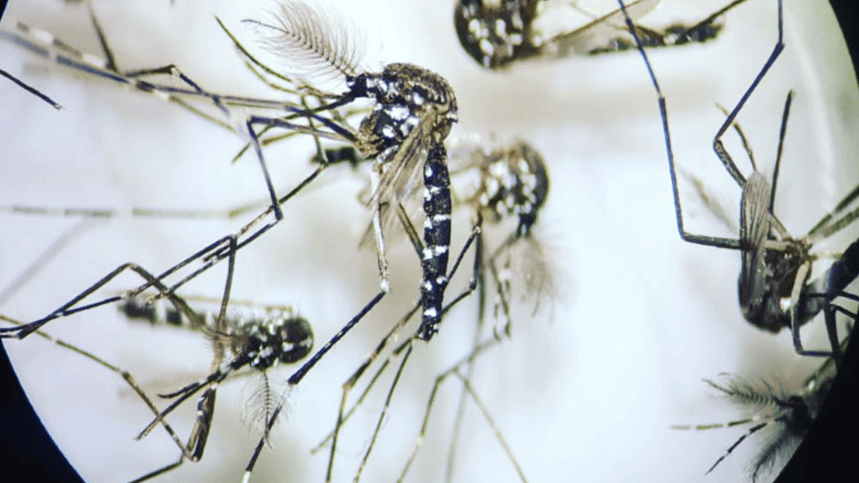A team from the Institute of Integrative Systems Biology (I2SysBio), from the scientific area of the University of Valencia Scientific Park (PCUV), participates in two projects funded by the City of Valencia and the Ministry of Science and Innovation, to reduce the population of the Asian tiger mosquito in the city
Researchers from the Institute of Integrative Systems Biology (I2SysBio, CSIC-UV), with the collaboration of the Cavanilles Institute of Biodiversity and Evolutionary Biology (ICBiBE) and led by Rosario Gil, researcher at I2SysBio and UV professor in the Department of Genetics, are involved in the molecular research of two projects, whose objective is to introduce the Wolbachia bacterium into mosquito eggs and create a population that when mating gives rise to sterile embryos.
Last week's rains and temperatures above 22 degrees Celsius have allowed mosquito eggs deposited on the ground to hatch and, after four or five days, the number of these insects to increase. The Asian tiger mosquito (Aedes albopictus) can transmit diseases such as Zika or dengue -although less likely than the African Aedes aegypti- and with the trend towards an increasingly warmer environment, it is a vector of potential diseases to be controlled.
In this sense, the I2SysBio researcher explains that one of the biocontrol systems being developed against the tiger mosquito is the use of Wolbachia bacteria, sometimes used to prevent the transmission of viruses and other times to prevent mosquitoes from reproducing. In Valencia no recent cases of virus transmission of serious diseases have been detected with these mosquitoes, as has occurred in Catalonia, although the Asian tiger has been installed for more than 15 years, so it is trying to control its population, in a project in which also collaborates the company Lokimica, specializing in pest control.
One of the biocontrol systems being developed against the tiger mosquito is the use of Wolbachia bacteria, sometimes used to prevent the transmission of viruses and sometimes to prevent mosquitoes from reproducing
Asian tiger mosquito (Aedes albopictus), under the magnifying glass. Photo: I2SysBio
"Wolbachia is an insect endosymbiont, that is, bacteria that live inside insects in specialized cells. That's my line of work," Gil explains. In the case of mosquitoes, Wolbachia, like most endosymbionts, is always located near the ovaries of the female to be transmitted from one generation to the next, directly through the eggs of the embryos. So what this bacterium does in the case of the tiger mosquito and the common mosquito, Culex pipiens, is to infect the females for its own benefit.
"Cytoplasmic incompatibility means that if a male carries one Wolbachia and mates with a female that carries another type of Wolbachia, the embryo will be sterile and will not be born. The male transmits a toxin in his sperm and the female carries the antitoxin from her cytoplasm. If the antitoxin is not the corresponding one, it does not neutralize the toxin and kills the embryo, and this is what we are trying to achieve," explains Rosario Gil.
Infecting tiger mosquitoes
The Wolbachia carried by the common mosquito is incompatible with the Wolbachia that normally infects the tiger mosquito. "In our research, we want to find an indigenous Wolbachia that is incompatible with the one naturally carried by tiger mosquitoes, produce large numbers of tiger mosquitoes infected with this new incompatible Wolbachia, and release males into the environment to mate with females," the researcher adds.
In addition, "currently, we are not only working with the Wolbachia of the common mosquito, we are also characterizing the Wolbachia of Drosophila melanogaster, which is also incompatible with that of the tiger mosquito, to then choose one. At the Cavanilles Institute we are keeping the tiger mosquito cured of its natural Wolbachia and at I2SysBio we are characterizing the common mosquito bacterium and the Drosophila bacterium. The next step would be to inject the one we select into the tiger mosquito before releasing it", completes Rosario Gil.
Rosario Gil's current project, funded by the Ministry of Science and Innovation, until 2025, "Host-symbiont communication and its utility in the biological control of pests and pathogens, SYMB-CONTROL", has a section, "Molecular characterization of native strains of Wolbachia in different insects, as a first step for its use in biocontrol", which is being applied with Aedes, Culex and Drosophila. The annual agreement with the city council is "Proposal for the generation of new tiger mosquito strains and possible pilot test of male release (incompatible insect technique, IIT) for the control of populations in a delimited and controlled area of Valencia", and is led by Antonio Marcilla, professor of Parasitology at the UV.
News



